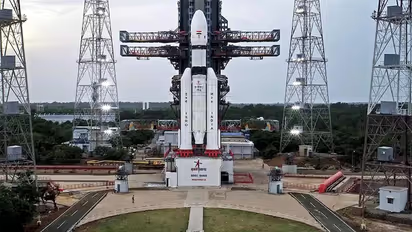Chandrayaan-3 launch: 'This remarkable mission will carry hopes and dreams of our nation,' says PM Modi

Synopsis
This marks India's second endeavour towards a soft landing, following the unsuccessful Chandrayaan-2 mission in 2019. In 2008, their initial lunar probe, Chandrayaan-1, successfully orbited the moon before deliberately crash-landing on its surface.
As India prepares for the launch of Chandrayaan-3 on Friday (July 14), Prime Minister Narendra Modi has extended his best wishes to the Indian Space Research Organisation (ISRO). He emphasized that this significant lunar mission holds the aspirations and ambitions of the nation.
In a tweet, PM Modi said, "14th July 2023 will always be etched in golden letters as far as India’s space sector is concerned. Chandrayaan-3, our third lunar mission, will embark on its journey. This remarkable mission will carry the hopes and dreams of our nation."
Chandrayaan-3: Nine crucial steps before LVM3 lift-off
Today, India is set to launch its Chandrayaan-3 mission, aiming to achieve a controlled landing on the moon. If successful, India will join the exclusive club of only four countries that have accomplished this feat. With a modest budget of approximately $75 million, the mission is scheduled to take off from the Satish Dhawan Space Center in Andhra Pradesh's Sriharikota at 2:35 pm.
This marks India's second endeavour towards a soft landing, following the unsuccessful Chandrayaan-2 mission in 2019. In 2008, their initial lunar probe, Chandrayaan-1, successfully orbited the moon before deliberately crash-landing on its surface.
Prime Minister Narendra Modi has expressed his admiration for the ISRO scientists, recognizing their previous lunar missions as groundbreaking ventures that have provided invaluable knowledge and insights to the world.
Chandrayaan-3: How ISRO decided on launch window of 2:35 pm
"Thanks to our scientists, India has a very rich history in the space sector. Chandrayaan-1 is considered to be a path breaker among global lunar missions as it confirmed the presence of water molecules on the moon. It featured in over 200 scientific publications around the world," he wrote, adding that the Chandrayaan-2 mission was "equally pathbreaking".
Chandrayaan-3, developed by ISRO, consists of a lander, propulsion module, and rover, with the primary objective of achieving a safe landing on the lunar surface. Its mission includes gathering data and conducting various scientific experiments to enhance our understanding of the moon's composition.
If all goes according to plan, the 43.5-meter LVM3 launch rocket will propel the spacecraft into an elliptical orbit around Earth. Subsequently, it will embark on a trajectory towards the moon and is scheduled to land around August 23.
Soft-landing a spacecraft on the moon's surface is a complex endeavour accomplished by only three other nations: the United States, Russia, and China.
Stay updated with the Breaking News Today and Latest News from across India and around the world. Get real-time updates, in-depth analysis, and comprehensive coverage of India News, World News, Indian Defence News, Kerala News, and Karnataka News. From politics to current affairs, follow every major story as it unfolds. Get real-time updates from IMD on major cities weather forecasts, including Rain alerts, Cyclone warnings, and temperature trends. Download the Asianet News Official App from the Android Play Store and iPhone App Store for accurate and timely news updates anytime, anywhere.